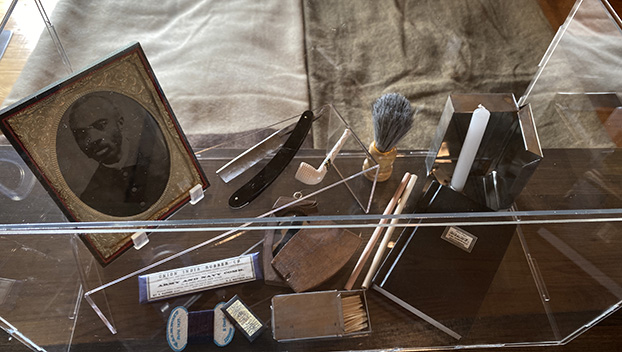Camp Nelson adds two new exhibits
Published 1:05 pm Wednesday, July 12, 2023

- Artifacts showcasing the service of Elijah Mars, who went on to be one of the founders of Simmons College in Louisville. (Photo by Gillian Stawiszynski)
|
Getting your Trinity Audio player ready...
|
Due to a new partnership between the National Park Service (NPS) and the Camp Nelson Preservation and Education Foundation, Camp Nelson National Monument has unveiled two new exhibits that will emphasize the human stories of the historical site and the U.S. Army’s unequal treatment of Black soldiers and their families who sought refuge at the camp.
These exhibits were made possible by a grant from the National Parks Service National Underground Railroad Network to Freedom.
Camp Nelson is an important site in the history of resistance to slavery through escape. During the Civil War, thousands of enslaved African-Americans risked their lives escaping to Camp Nelson for freedom from nearly 300 years of enslavement of themselves and their ancestors.
The Camp Nelson Preservation and Education Foundation’s role in these exhibits is instrumental. Because Camp Nelson is a part of the NPS – a government entity – the NPS staff cannot apply for federal grants. But the foundation is.
“We wanted to work with the Camp Nelson Foundation because they can apply for the grant,” said Steve Phan, the chief of interpretation, education and visitor services at Camp Nelson. “So in partnership with the foundation, they applied for it and were willing to cover half the cost. Really, it would not be possible without them.”
The total grant award was $5,800, including a match by the foundation, which paid $2,900 to make the exhibits possible.
The new exhibits are in the site’s reconstructed U.S. Army barracks, which housed Black and white soldiers from 1863 to 1866.
The first exhibit is entitled “True to the Cause of Freedom.” It includes a wayside and wall panels interpretively telling stories of African-American Civil War veterans, their experiences escaping to Camp Nelson and the inequalities they faced once joining the U.S. Army.
All the information displayed on these panels and the wayside was informed by “invaluable insight” from a civil rights historian and established research, Phan said.
The room also includes the “Soldiers Exhibit.” What was once empty double bunk beds is now an interpretive showcasing of these soldiers’ time at Camp Nelson.
“This exhibit brings a human face, perspective, and voice of the tens of thousands of soldiers who marched through here 160 years ago,” Phan said.
The inspiration for the soldier’s exhibit was partially the geographic span of this site.
“I think people would be surprised to learn there are African American soldiers here, but there are also white soldiers from Kentucky and East Tennessee that also enlisted at Camp Nelson and served for the U.S. Army. People come from all over the place to Camp Nelson, and from Camp Nelson, they also go all over the place,” Phan said.
“We try to personalize it as much as possible, as you can see the images or the tin types, we basically took copies of the originals, and we just had those mounted on plates in the frames. We’ve got their tintypes and then just personal items, right, everything that soldiers would carry from brushes, matches, candles, books, sketchbooks, shaving equipment, and all that stuff.” Phan said.
Because of the work of the foundation and the NPS, and the excellent record keeping of the U.S. Military, this exhibit will soon include panels that tell the stories of the individual soldiers displayed in the seven different photos on the bunk beds.
Visitors can expect to see this update in the next few weeks.
“We want you to see who these people are and then read through their stories,” Phan said.
Phan described the life of one of the seven made on display at the bunks.
“We’re looking at Elijah Mars right now. He was in the 12th U.S. colored heavy artillery. He was one of the co-founders of Simmons College in Louisville, which is a historically Black college and university, so he was a soldier at Camp Nelson, and he went on after to help establish an HBCU, which is incredible, right? We know who they are. That’s why we did this,” Phan said.
Small panels will be added near the soldier’s photo in the upcoming weeks.
Civilian workers, including a farrier (equine hoof care expert) outfit with the correct tools, are also represented at the exhibit. Phan said the team plans to add even more civilian worker displays.
While civilian workers’ records weren’t kept as well as the soldiers, women, particularly African-American women, worked as cooks and washerwomen at Camp Nelson. Phan said those workers’ scenes would soon be recreated in the exhibit.
From empty bunk beds to a whole new exhibit – the park’s staff put it together on their own.
“The parks staff worked on the interpretive text and design, and we shared it with the foundation members, had their reviews and edits, and then it was park staff – our intern team, our maintenance team, and our volunteers. Imagine park rangers creating wooden mounts for these exhibits. It was really funny to watch! It was like Tim ‘The Tool Man’ Taylor thing going on, but it was a great team-building exercise,” Phan said.
The foundation has one more addition to the park- a way to donate to the park. It’s a dip jar in the visitor’s center where folks can dip their debit or credit card and instantly donate $5.
Camp Nelson National Monument is at 6614 Danville Road.





